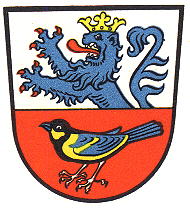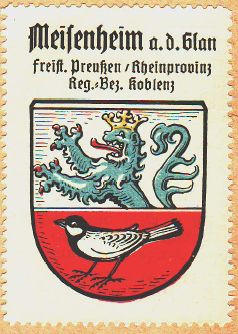Meisenheim: Difference between revisions
Knorrepoes (talk | contribs) m (Text replacement - "{{de}}" to "") |
Knorrepoes (talk | contribs) m (Text replacement - "{| class="wikitable"↵|+Official blazon↵|-↵|'''German'''↵| ↵|-↵|'''English''' ↵| {{blazon wanted}}↵|}" to "{| class="wikitable" |+Official blazon |- |'''German''' | blazon wanted |- |'''English''' | blazon wanted |}") |
||
| Line 13: | Line 13: | ||
|- | |- | ||
|'''German''' | |'''German''' | ||
| | | blazon wanted | ||
|- | |- | ||
|'''English''' | |'''English''' | ||
| | | blazon wanted | ||
|} | |} | ||
Revision as of 08:03, 6 April 2023
MEISENHEIM
State : Rheinland-Pfalz
District (Kreis) : Bad Kreuznach
Verbandsgemeinde : Verbandsgemeinde Meisenheim
| German | blazon wanted |
| English | blazon wanted |
Origin/meaning
The arms are a combination of the lion of the counts of Veldenz and a canting symbol (Meise=tit)
Meisenheim became a city in 1315. The city rights were granted by King Ludwig of Bavaria. The town was owned since the 12th century by the counts of Veldenz. The arms are based on the first seal of the town, dating from the 14th century. It already showed the lion and the tit.
In the 18th century other arms appeared on the seal of the town. These arms showed the lion over a cross-chequered field. The tit was places on an escutcheon. The arms thus reflected the fact that the counts of Veldenz were replaced by the Wittelsbach family in 1444 (see Veldenz). The arms of the Wittelsbach family are a cross-chequered filed of white and blue (see also the arms of Bavaria).
The old arms were restored in 1935.
| The arms by Hupp in the Kaffee Hag albums +/- 1925 |
Literature: Stadler, 1964-1971, 8 volumes.

